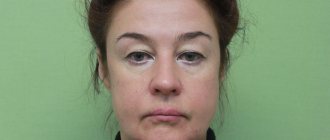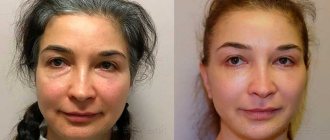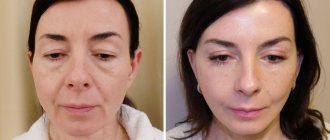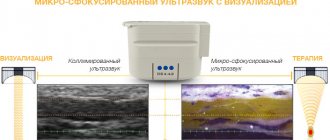- home
- Facial plastic surgery
- Circular face and neck lift in a clinic in Moscow
Circular facelift, or facelift, is an operation whose purpose is to reduce age-related changes that occur on the face and neck. Facelift restores the contour of the face and neck by returning sagging facial tissues to their previous position. During the operation, excess skin is eliminated, facial muscles are strengthened and a new contour is formed.
A priority direction of modern medicine in the field of surgical rejuvenation can be considered manipulations aimed at restoring young facial anatomy. Restoration of not only its external, but also internal structures. After all, facial aging is not so much caused by the appearance of excess skin. The main processes leading to age-related changes in the face are associated with deformation and changes in the position of fat, muscle tone and bone resorption.
The progress that has occurred in understanding the essence of age-related changes in the face has largely changed traditional approaches to surgical lifting methods. There has been a transition from simple facial skin tightening to its combined correction, working at deeper levels of the tissues of the face and neck.
The patient underwent surgical SMAS facelift. Previously, blepharoplasty was performed. During this operation, we corrected the oval of the face and neck.
Go to photo gallery
Overview of plastic surgery for facelift
Facelift (facelift) is a type of surgical intervention in which the skin of the face and neck is tightened, as well as excess skin and fatty tissue are removed. The stress of everyday life, sun exposure, genetic factors and gravity all contribute to the changes we see in the mirror as we age. Wrinkles and crow's feet appear in the corners of the lips and eyes, lines on the forehead turn into deep folds, cheeks droop, depressions form in the nasolabial folds, and the muscles of the face and neck become weak. A facelift will help you turn back time! After it, you will look as good as you did several years ago.
In the photo: the progress of the operation
Execution technique
Some women are afraid to undergo a circular facelift because they have little idea of how the operation is performed in modern conditions. And they think that everything is the same as twenty years ago.
The use of laser technologies and new methods have made plastic surgery much less traumatic. They allow you to make do with a few small cuts, the marks of which will be almost invisible.
At the preliminary consultation, a computer simulation of the expected result from a circular lift is required. It is this that helps the doctor determine the locations of future incisions as accurately as possible.
Typically, cuts are made behind the ears, along the hairline and under the chin. Therefore, even in the first time after the intervention, they can be very easily hidden.
A good clinic will definitely show a video of how the operation will take place. The doctor will make sure that the patient feels calmer, knowing exactly what he will have to endure.
After administering anesthesia, the surgeon carefully separates the facial skin from the subcutaneous tissue. This process must be performed as carefully as possible. Therefore, the duration of the operation is difficult to predict in advance - it can last from 2 to 5 hours.
If necessary, liposuction is performed at the same time. Then the skin is stretched, excess is removed, and fixation is performed with cosmetic sutures using high-quality thread.
Finally, a sterile dressing is applied. The patient can now be transferred to the intensive care unit. Not for long - just to make sure that after coming out of anesthesia everything is fine with him.
Circular facelift techniques
Allocate a lift:
- upper zone (forehead lift);
- middle zone of the face;
- lower (buccal-mandibular region and neck).
Operations can be performed either separately for each area of the face or in combination.
Depending on the needs of the patient, the degree of age-related changes and the preferences of the plastic surgeon, one or another method is selected, which will be the most optimal choice for solving your particular problems.
The most popular today are:
- SMAS
- endoscopic
- deep
- S-shaped
- MACS
- on the middle part of the face
- on the frontotemporal region
- on the cervical area
- using Aptos threads and others
Traditional circular facial surgery
It is carried out mainly for patients over 45 - 50 years old, it is aimed at solving significant age-related changes and allows you to rejuvenate your appearance by 10 - 20 years. It is performed under general anesthesia or in combination with local anesthesia and light intravenous sedation. The surgeon makes an incision in the temporal part of the scalp, then goes down in the preauricular region, goes around the earlobe and passes into the scalp of the occipital region. Next, the skin is peeled off from the adjacent tissues (this also includes muscle tissue), its excess is cut off and, finally, the tissues are fixed in a new position and stitched.
The duration of circular plastic surgery is 3-4 hours.
Sutures are usually removed after 10 days, traces of incisions are visible within 2-3 weeks.
Despite the traumatic nature, the location of the incisions in natural folds makes it possible to hide the traces of the operation from prying eyes; after 6-12 months, the scars become completely invisible.
Traditional facelift provides long-lasting and simply amazing results! Even in 10-15 years you will look much younger than your peers!
Anesthesia
Some complications may result from problems with anesthesia. This could be an allergic reaction to the drug or an incorrectly calculated dosage. The consequences of unsuccessful anesthesia are quite serious. But such complications occur extremely rarely, mainly in dubious places working without a medical license, or by doctors with unconfirmed qualifications.
Licensed plastic clinics use the latest generation of drugs that are safe for the patient. During the operation, an experienced anesthesiologist monitors all vital signs and promptly adjusts the dose of anesthesia if necessary. To exclude the occurrence of an allergic reaction, the patient undergoes a consultation with an anesthesiologist before the operation, who, based on the patient’s current health condition, selects the optimal type and dose of the drug.
SMAS facelift
Currently, the extended SMAS lift is the best known and most frequently performed technique. It is indicated for patients under 45 years of age, but can also be performed at older ages.
SMAS stands for muscular aponeurotic system, it covers the fatty tissue and keeps the facial muscles in their normal position. Plastic surgery that affects muscle tissue is called “SMAS-lifting” and is one of the traditional types. Working out the muscle complex guarantees a more obvious and lasting rejuvenating effect.
During the operation, incisions are made both in front of the auricle and behind it, extending into the scalp, then the superficial muscular aponeurotic system is mobilized and sutured in a new position. SMAS lifting lasts about 2.5 - 3 hours.
After SMAS, the stitches are removed on days 10–12.
Scars become almost invisible after 2 months. You will be able to start work 2 weeks after the operation.
SMAS technique allows you to perform the most complete rejuvenation, at almost all levels! The results will be amazing within 10 - 15 years!
Read more about SMAS lifting here
Deep facelift
Anatomical studies have shown that performing surgery one layer below the SMAS, rather than above it, can prolong the longevity of the results. Deep lift is a relatively new technique and a variation of the traditional technique.
In the process of deep surgical intervention, the entire thickness of the soft tissue is affected, which ensures natural and long-term results.
The main candidates for a deep facelift are elderly patients aged 55-60 years with gross age-related changes in the form of deep wrinkles, bags, folds and depressions. The procedure allows you to achieve the highest efficiency in eliminating pronounced age-related changes in the middle and lower part of the face (cheek area, nasolabial folds, lower jaw, chin, neck).
This procedure is the best choice for smokers, since the greater thickness of the complex of mobilized tissues allows tissue microcirculation to be maintained and promotes faster wound healing.
The recovery period takes up to 2-3 weeks, after which it becomes possible to evaluate the final result of the operation. To shorten the rehabilitation period, it is recommended to undergo a course of special physiotherapeutic procedures. The effect of a deep lift will last 10-15 years!
Complications
In some cases, more serious complications may occur. You should consult a doctor if your body temperature does not drop below 38°C for several days. The constant increase in swelling is also a cause for concern. But this phenomenon should not be confused with “floating” swelling, in which tissue swelling increases in the morning and decreases in the evening.
If sterility in the operating room is not maintained or sutures are not taken care of, wounds can become infected. During the recovery period, the patient must carry out antiseptic treatment of sutures daily to avoid infection. The doctor may also prescribe antibiotics to suppress the development of the infectious disease.
Any situation that causes concern or causes serious discomfort is considered a reason to contact a surgeon. If the condition is serious and it is impossible to visit a surgeon, it is permissible to go to the nearest clinic or call emergency services.
Endoscopic facelift
It is a minimally invasive surgical technique. It is performed using a probe with a video camera and special instruments through small incisions (up to 2 cm) in the scalp and oral cavity.
The use of special equipment allows the surgeon to obtain a magnified image of the tissue. Maintaining blood flow in the skin and tissues significantly reduces the severity of swelling and negates the likelihood of baldness.
Ideal candidates for endoscopic repair are:
- Young patients (from 30 to 40 years old) with the first stage of aging and pronounced changes in the upper and middle zone of the face (most often caused by genetics)
- Men
- Patients requiring re-lifting of the upper and mid-face area
- Patients with deep horizontal and glabellar wrinkles in the forehead area
- Patients with drooping or drooping eyebrows
Endoscopic lifting is performed under general anesthesia or local anesthesia in combination with intravenous sedation. Its duration is 2.5 - 3 hours.
The stitches are removed after 8-10 days. The rehabilitation period is 9 - 14 days. Endoscopic plastic surgery leaves virtually no scars.
At the same time, the procedure allows you to smooth out vertical and horizontal wrinkles in the forehead and eyebrow folds, eliminate crow’s feet and bags under the eyes, lift drooping eyebrows, and even out the contour and oval of the face.]
Endoscopic facelift can be combined with blepharoplasty, lipofilling, and neck lift. This is an ideal choice for young patients with problems in the upper and middle third of the face without significant excess skin, which makes it possible to do without incisional surgery. This technique is not inferior in results to open facial plastic surgery and allows you to achieve excellent and harmonious rejuvenation.
Rehabilitation after facelift by day
Surgical facelift is a very complex surgical procedure that leads to a long and difficult recovery period.
On the first day, the plastic surgery itself is performed - facelift. Since anesthesia is used, after surgery the patient remains in the plastic surgery clinic. Possible deterioration of health, in particular, the following appear:
- lethargy and disorientation (lasts several hours after surgery);
- nausea and vomiting;
- pain – its severity is minimal; if the pain threshold is low, the patient may be recommended painkillers;
- postoperative swelling on the face, which will progress over the next few days;
- hematomas in the area of facelift, which subsequently disappear completely.
The second day after surgery is an examination by a plastic surgeon. If the patient’s condition is satisfactory and no early postoperative complications have arisen, he is discharged home. It is strictly forbidden to remove the compression bandage within 2 days after facial surgery. If pain in the surgical area increases, analgesics should be taken.
On the third day after surgery (but in most cases on the 5th day), the plastic surgeon allows you to remove the compression bandage. The condition of the skin after facial contour lifting can be shocking, as there are numerous bruises and severe swelling. But do not worry, as these post-operative signs will disappear within 14 days.
In the following days of rehabilitation, the patient's condition will improve. The patient may feel a feeling of heaviness and stiffness in the surgical sites. There may also be some slight pain at the skin incision sites.
The patient can begin to return to their normal lifestyle 14-21 days after the facelift. Final tissue healing occurs after 5 months. It is at this time that you can see the final results of the facelift. Reviews after facelift written by patients are the best confirmation of this.
S-lifting
The short scar technique is a form of mini facelift, as well as a modification of the SMAS lift. With this technique, an incision is made in front of the auricle in an “S” shape, with rare exceptions an additional incision is required in the temporal region of the scalp. Ideal candidates for an S-lift are patients between the ages of 30 and 45 who do not have significant sagging neck skin that requires removal of excess skin.
This technique allows you to significantly rejuvenate the middle and lower third of the face:
- eliminate jowls;
- remove double chin;
- eliminate sagging in the cheeks and cheekbones;
- get rid of pronounced nasolabial folds;
- remove minor sagging neck skin;
The rehabilitation period after an S-facelift is much shorter than the “traditional” one; most patients return to work after 7 - 10 days. Discharge from the clinic occurs the next day after the operation. It is necessary to wear a compression bandage for 5-7 days. Swelling and bruising subside within 4 to 6 days. In the first week, slight pain may occur when chewing due to subcutaneous sutures, so during this time the food should be soft and semi-liquid. Usually after a week all unpleasant sensations disappear.
The procedure allows you to achieve long-term natural rejuvenation results.
How to care for your face after a thread lift
1-3 days after thread lifting. Home mode. Minimum physical and mental activity; it is recommended not to use facial expressions when communicating. It is best to be in a reclining position, silently read a book, draw, watch TV shows or videos without emotions. It is optimal to listen to the radio or your favorite audio recordings. You cannot touch your face, wash your face, or apply creams and ointments (except those prescribed by the doctor). You need to sleep on your back. Consume food and water warm. Food should be neutral in taste and soft in order to use a minimum of muscles when chewing it. It is better to drink water through a straw or from a sippy cup. Alcohol and smoking are strictly prohibited! Be sure not to remove the compression mask for the first three days!
4-7 days. If necessary, you can leave the house. Avoid hot food and drinks, exposure to the open sun, solarium, sauna. Do not touch your face with your hands, do not use cosmetics. Communicate without facial activity: do not laugh or smile. In the summer, be sure to wear a wide-brimmed hat or Panama hat when leaving the house. Sports, light fitness, jogging, morning exercises, any physical activity (including intimate) is prohibited. If the swelling has decreased significantly, you can wash your face using warm boiled water and a clean cotton pad using gentle, gentle blotting movements. At home, wear a compression mask and sleep in it.
8-14 days. You can eat your usual food at any temperature. Walking during periods of low solar activity returns to the daily routine. Sauna, beach and solarium, and other hot temperatures are not yet for you. Massage, cosmetics, intense physical activity, including facial expressions, are also prohibited. But you can wash your face more confidently with warm water using a cotton pad. In this case, a face that has recently been lifted should not be rubbed or squeezed. You can sleep not only on your back, but also on your side (but you shouldn’t sleep “with your head buried in the pillow” yet).
15-30 day . Return to normal daily routine. Expanding your social circle. Sleep in your favorite position, morning and evening washes. After washing, gently dry the skin by applying a soft, clean towel (preferably disposable) to it with blotting movements. It is allowed to go to work that does not require physical activity. There is no need to visit the sauna and solarium, play sports and fitness, or go on vacation to a hot country.
A month later, after the doctor’s approval, you can gradually return to your normal lifestyle.
Mini facelift
Similar to circular, but affects only certain areas (for example, cheeks, neck and chin), and not the entire face. Recommended for patients who see the first signs of aging and want to slightly tighten their skin with minimal incisions. It is performed through an s-shaped incision in the temple area in front of the ear, without going into the area behind the ear. This method is a modification of SMAS lifting, but is performed under local anesthesia. The operation lasts only 1-2 hours (instead of 3-4 with the classic version).
Providing excellent results, the mini lift has a short recovery period (only 1 week) and minimizes the risk of swelling, bruising and bleeding. In addition, the price of the procedure is significantly lower than a classic facelift, which is an obvious additional advantage when choosing.
Mini-lifting does not involve serious surgical intervention, which eliminates the fear of looking “unnatural” later. If you are between 36 and 45 years of age and want to remove minor sagging in the cheekbone, mid and lower face with minimal incisions, this surgery is the ideal choice for you.
Contraindications
The likelihood of complications increases greatly if a patient undergoes surgery who, for medical reasons, should not undergo surgery. To exclude such a situation, before correction, mandatory tests and examinations are prescribed, which include general tests and biochemistry, coagulography, electrocardiography, fluorography, and more. The patient must also obtain a physician’s report with permission to undergo surgery. Contraindications for correction:
- bleeding disorder,
- decompensated diabetes mellitus,
- infectious and inflammatory diseases,
- chronic disease in the acute phase,
- diseases of the cardiovascular system,
- oncological diseases.
Pregnant and lactating women will also have to refrain from surgery; it is better to schedule a visit to the surgeon for a time after the end of lactation. Facial plastic surgery is not performed on patients under 18 years of age.
Only adult patients are allowed to undergo facial plastic surgery.
MACS - lifting
A surgical facelift aimed at eliminating sagging in the middle and lower part of the face. Suitable for patients aged 40 to 55 years who want to correct the oval of the face, eliminate jowls, smooth out nasolabial folds, and increase the tone of the tissues of the chin and cervical areas. This technique is especially effective in young patients. MACS is a modified S-lift technique and is limited to a minimal scar in front of the auricle. During the operation, a small amount of excess skin is removed and the sagging tissue is fixed in a vertical direction using two or three purse-string sutures. By applying two purse-string sutures, ptosis of the cervical region and cheeks is eliminated. The third purse-string suture improves the zygomatic area, the area of the lower eyelid, the nasolabial fold and the middle area of the face. The duration of the operation is 2.5 hours.
The rehabilitation period is 2 - 3 weeks.
Most patients return to work within 10 days.
Allows you to maintain a natural look thanks to the vertical tension of the skin versus the traditional lateral one.
A small area of skin detachment allows you to maintain nutrition and blood supply to the tissues, which reduces the risk of difficult-to-resolve swelling and hematomas, which is extremely important for smoking patients.
MACS lifting will not lead to the removal of bags under the eyes, wrinkles in the eye and forehead area, therefore, to obtain comprehensive rejuvenation, it is recommended to combine MACS with blepharoplasty, forehead and eyebrow plastic surgery.
Midface lift
Mid face lifting provides complete rejuvenation in the area of the lower eyelids, cheekbones and cheeks. It improves the area from the cheekbones down to the upper lip and slightly smoothes out the nasolabial folds. This operation is suitable for fairly young patients who do not yet need a circumferential lift. It is characterized by a short recovery period (after 1 week, most patients return to work), mild postoperative swelling and bruising, and a lower cost of surgery.
Performed using two different techniques.
In the traditional technique, access to the cheeks and lower eyelids is carried out using an incision under the ciliary edge of the lower eyelid (or transconjunctivally). Sometimes an incision is required from the side of the oral cavity (in the area of the transitional fold of the vestibule of the oral cavity). The procedure takes 1.5 - 2 hours and is performed under general anesthesia. This technique is suitable for patients who need to tighten the skin upward rather than horizontally and diagonally.
The use of the second method involves the presence of two endoscopic incisions in the scalp of the temporal region. In this case, the surgeon has the opportunity to lift the facial muscles and skin both vertically and diagonally, which improves the appearance of the eyes, cheekbones and eyebrows.
Regardless of the technique used, midface plastic surgery can correct bags and wrinkles in the lower eyelid area.
Bruising and swelling will subside in approximately three to four days. Scarring and slight swelling at the outer corner of the eyebrows may be noticeable for 3 to 5 weeks, but the final result is usually not visible until several months after surgery.
The guaranteed result lasts for 7 - 10 years.
What is rhytidectomy
A circumferential facelift (rhytidectomy) is not a cosmetic procedure, but a major operation.
And you should resort to this truly radical method of rejuvenation only when other methods no longer help. Very often it is enough to perform correction only in a single area - for example, removing a double chin or doing blepharoplasty. But when it is necessary to solve several problems at once, such an operation is effective.
Circumferential lifting is usually used to improve your appearance. Thanks to it, skin sagging, jowls, the depth of nasolabial folds and age wrinkles are reduced. It also helps get rid of double chin.
How to do a circular facelift:
- The skin is redistributed.
- Excess skin is trimmed.
- The muscles responsible for facial expressions are strengthened.
- A clearly defined facial contour is formed.
After the operation is completed, the patient's neck and cheeks acquire a more pronounced contour, the chin and cheekbones become sharper. The skin is rejuvenated and gains the desired elasticity.
Advantages
What is a classic circular facelift? In the early 2000s, it suggested a simple detachment of the skin. The entire load fell on the area where the sutures were placed.
The results obtained lasted only up to 2 years. Moreover, ugly scars negated the entire lifting effect. Today, the main load is distributed on the facial muscles. Therefore, the seams are completely invisible.
The main advantage of a circular lift is its longevity. It lasts for a period of 10 to 15 years. And an equally important plus is that it is able to cope with even the deepest wrinkles and sagging skin.
No cosmetic procedure can provide such an effect. You can have filler injections for years on end and pay impressive sums for them. However, in this case there can be no talk of a radical solution to the problem of age-related changes.
Flaws
Not everyone knows that the effect of a classic circular facelift is quite short-lived. Plastic surgeons, unfortunately, do not always report this.
If you tighten only the skin without affecting the muscles, it will soon begin to sag again. You should not expect that after such an operation a woman will remain young for another 10-15 years.
The disadvantages include a fairly long rehabilitation period (about three weeks). In addition, often the result of lifting is more or less very different from the predicted one.
A favorable outcome largely depends on the skill of the surgeon. But even the most qualified doctor cannot guarantee that nerve endings will not be damaged or any other complication will not arise.
Temporal lift
Designed to eliminate age-related changes in the upper facial area. Helps lift the outer corners of the eyebrows, smooth out wrinkles in the corners of the eyes, slightly lift the upper eyelids, fatty tissue in the cheekbones and sagging cheek tissues. During a temple lift, small incisions are made in the temporal part of the scalp. More information about frontal-temporal lifting can be found here










